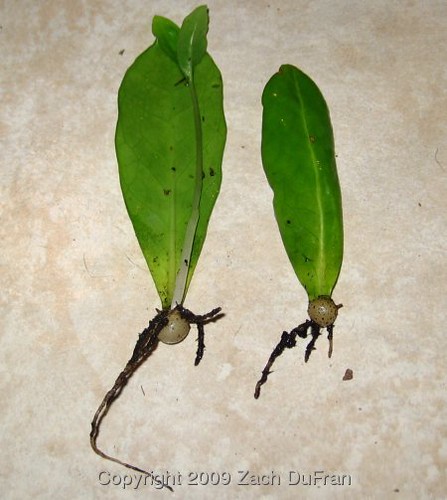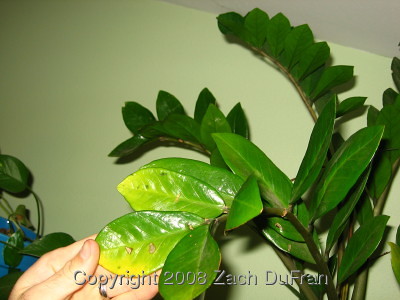Zamioculcas zamiifolia is an unusual Aroid that is commonly kept as a housplant. It has several interesting common names, including ZZ Plant, Aroid Palm, and Succulent Philodendron. If you'll remember the old Sesame Street game and were given a line up of Aroids, including the ZZ Plant, I can guarantee everyone would pick the ZZ as the plant that is "not like the others."
And unlike other Aroids, the ZZ plant has a unique method of propagation. Many plants can be rooted from a single leaf; this is a common method for Begonias and African Violets. But the ZZ plant doesn't merely produce roots when a leaf is used for propagation.
I received a ZZ Plant from my Aroid-collecting friend, Russ, about 9 months ago. Somewhere in the mix, a couple of leaves fell off the plant and I decided to try a propagation technique that I heard was somewhat successful for ZZ plants. I stuck two of the leaves into the potting soil, right next to the rest of the plant. I haven't given the plant any special care whatsoever. It has been sitting outside in the shade and getting watered with the rest of my plants - weekly or a little more often when it is really hot and dry.
Recently, I was repotting my ZZ plant into a more suitable container when I noticed that one of the leaves had a new stem growing next to it. I gently removed each of the leaves from the soil to find that both of them had successfully begun to produce new tubers! I have read that this process can be very slow - often a year or more. I'm pretty sure mine has not been in the soil for more than 6-8 months and both of them have taken.
 |
| Zamioculcas zamiifolia leaf starts |
Most Aroids can not be propagated from a single leaf and petiole. Most Aroids require at least one section of stem (from joint to joint) in order to produce roots and form a new plant. The ZZ apparently carries all of its reproductive needs within the petiole. I have had one occasion where I propagated a Monstera from a single leaf and petiole that had been torn off my plant by my Boston Terrier, Pee-Wee. I haven't heard of other people propagating Monsteras this way, so I'm not sure how successful this type of propagation normally is. I just stuck the long petiole in water, not really expecting anything to happen, just enjoying the leaf while it was still green. The leaf never browned and eventually started forming a thick white root from the base of the petiole.


Wow! Fascinating! I love the zz plant....hmmm....will have to sneak a leaf. :-)
ReplyDeleteThat is unusual. I've never seen the ZZ plant before but it looks very enticing.
ReplyDeleteGreat post. Not seen that before and I love ther Aroids. Never seen one over here.
ReplyDeleteAnyone ever seen the Zamioculcas Zamiifolia variegated version of this plant? Also called Variegated ZZ Plant... I purchased one on EBAY from someone living in Thailand, I had it shipped to Orangeburg, New York. Plant arrived in good shape and is really cool looking since it is variegated.
ReplyDeleteYo compre una ZZ, es preciosa y el color brillante de las hojas es muy lindo.
ReplyDeleteLa voy a cuidar como me dicen. Ah! ya sembré dos hojas. :)
Gracias por toda la información.
Después le tomaré fotos para que la vean.
I actualy had one leaf that was broken off from a plant in the store.. and I decided to just put it in the glass with some water.
ReplyDeleteJust a bit of water.. covering the bottom part of the leaf. And to my surprize.. it has roots already. Its been couple of weeks. I did not pay attention to it ..
It was in my bedroom.. not by the window .. but by the bed.. regards lighting. So I did read that it should be put in the soil.. but it grew roots in the water as well.
Just wanted to share.
Hi I tried propagating using the method you described and i tend to water it once a day if i see the surface dry up
ReplyDeleteSome of the leaves have turned red brown. Are they dead? And should I discard them? I stuck two leaves in one container and one turned red brown while the other remained green? What shoudl I do?
What is the frequency of watering?
Also, as to the container where all the leaves turned red brown, should i discard all the soil as well?
thanks
Anna-
ReplyDeleteThanks for visiting my blog and leaving your comment.
I'm glad to hear you're giving this a try. My experience is that it can take a long time (6 months) for the new tuber to form and a plant to start growing from leaf starts. If a leaf turns brown my guess is that particular leaf will not start a new plant and you can probably remove it. It sounds like you could be watering too often. The soil just needs to be moist. It doesn't ever need to be wet. I would wait until the soil seems to be getting dry before watering again. You might want to push a little soil aside to see if it is dry an inch down into the soil, as well. If only the surface is drying up, you don't need to water yet. When you do water, only do it enough to moisten the soil.
Another thing that could help would be to cover these pots to keep the humidity up and remove the need to water. This is how I have been propagating other plants from cuttings lately and it works very well. The only issues I run into in this scenario is when mold will start to grow. When that happens, I spritz the moldy areas with a 1/4 teaspoon of apple cider vinegar diluted in a quart of water.
Let me know if you have any more questions.
Neat! I tried propagating from one ZZ leaflet, but it died - I think it dried up in the hot California summer sun.
ReplyDeleteA long time ago when I was a kid, I also propagated a Monstera from one leaf. Just chopped it off and stuck it in a jar of water. It took a couple months or so, but eventually it did root.
I cut off 2 branches and put in a vase of water. In a few days the tuber started growing and just after that the roots.
ReplyDelete